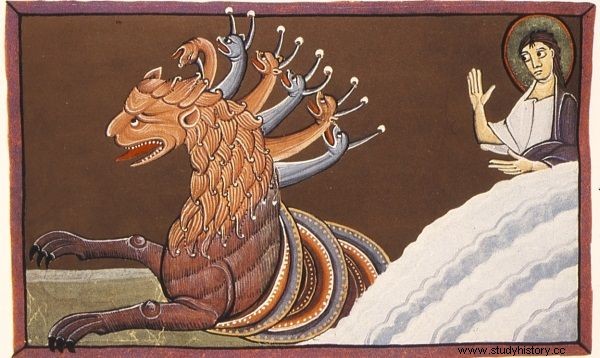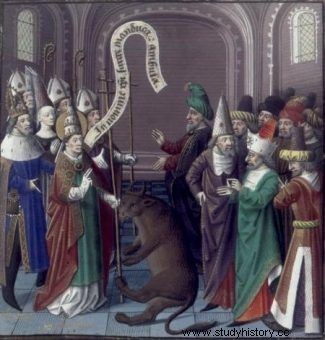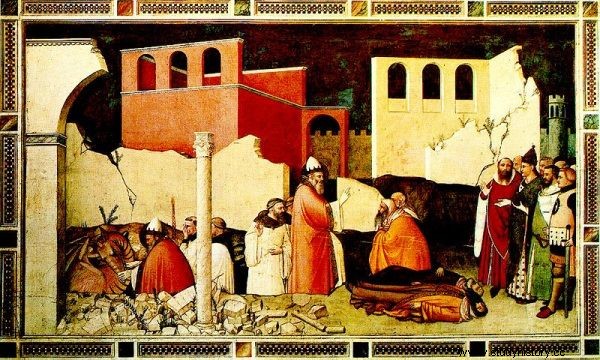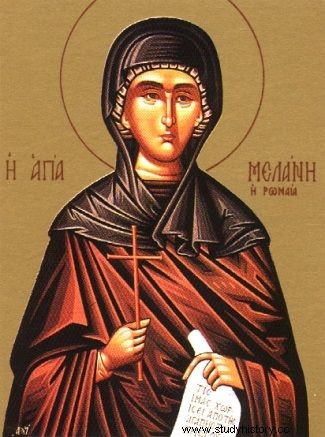Celebrating New Year's Eve. A custom more deadly than Tutankhamen's curse, more perverse than the Indians' tobacco revenge. Every year it takes a deadly toll. And it could have been otherwise!
Did you go overboard again last New Year's Eve? First day of the new year wasted? Ibuprom and water without gas are no longer enough? Not! It's not your fault. Don't blame yourself. For you have fallen victim to, if not a conspiracy on life and health, then at least one of the greatest misunderstandings in history! And who arranged us like this? Historians, of course.
Not this New Years Eve
December 31 is the name day of New Year's Eve. Everyone knows it. They also know that it is about some saint, probably a pope, that something was there with that year 1000, and that the world was to end, everyone was afraid, and the end did not come. It was then that the crowds allegedly first entered the streets to celebrate the coming of the new year.
However, there is a small snag:on December 31, we remember Saint Sylvester I - the patron saint of domestic animals, the bishop of Rome from 314, who died on December 31, 335. So living seven centuries before 1000! By the way - quite boring.

Saint New Year's Eve, upgraded version. Probably that was how he defeated the dangerous dragon…
His pontificate coincided with many important events in the history of the Church, but in virtually none of them he played a greater role personally. He was probably quite a skillful politician who knew how to use the favor of Emperor Constantine the Great for the Church. The most important resource for researching the early history of Liber Pontificalis The (Book of the Popes) lists mainly the donation received by Sylvester from the hands of the emperor.
There is also a legend that it was this Pope who baptized Constantine on his deathbed. It would be quite difficult, however, since Constantine outlived Sylvester by several months.
Forgeries and gibberish
Legends on New Year's Eve I, and even the usual chants, persisted even after death. The most famous is the so-called donation (donation) of Constantine. This is an outright forged document that Constantine allegedly transferred imperial powers in the western part of the empire to the bishops of Rome.
The authenticity of this document aroused controversy immediately after its "disclosure" (dating from the years 750-850), which did not prevent the papacy from using it as the basis for its claims to sovereignty over the Christian world. It wasn't until the 15th century that it was finally considered a counterfeit.
One can only guess that the document itself was written by some not very smart historian from the Roman curia. Falsifying acts attesting to the claims of the papacy was an old tradition by then. For example, the documents forged in the curia of Pope Symmach (d. 514), which were used in his disputes with the antipope, Lawrence, are famous.

New Year's Eve (second) with the devil for your brother.
Another pseudo-historian, Blessed Jacob de Voragine, described in his "Golden Legends" (ie a collection of stories about saints) the story of how New Year's Eve defeated and locked in the underworld the dragon-satan terrorizing Rome. This is just an achievement worth a celebration of its own! The dragon would eat three hundred people a day. Perhaps it was this legend - certainly known before de Voragine wrote it in the thirteenth century - that gave rise to the association of New Year's Eve with the end of the world and the alleged mass panic in the streets of Rome.
In the words of the prayer, thanks to which Sylvester defeated the dragon, there is a passage in which the Saint orders the dragon to stay in the basement "until His [Christ] comes." The Lives of Saints - especially the semi-legendary ones - were once taken very seriously.
You have plenty of New Year's Eve with us
Okay, but what does the thousand year have to do with all of this? Well, the second New Year's Eve is entering the scene. Or rather, New Year's Eve II. Contrary to Sylwester I, he is an extremely interesting character, also due to Polish matters. Gerbert of Aurillac (that was his name before he became Pope) is one of the most outstanding scholars of his time, teacher, friend of Emperor Otto III.
It was he who canonized Wojciech (999) and created the archbishopric in Gniezno (1000). He was a Benedictine, educated, inter alia, in in the Arab schools of Catalonia. He knew about astronomy and mathematics. He is credited with the spread of Arabic numerals (but in the version without a zero). These interests did not meet with unanimous approval in medieval Europe. Hence, Sylvester II was often portrayed in the company of the devil.

Sylvester (the First) had bad eyesight. Or at least people liked to imagine him that way…
New Years Eve was Pope for only 4 years. He began his pontificate in the year 999. The year 1000 might have raised gloomy questions. Will the dragon-satan imprisoned by the previous Sylvester come out of the Roman underworld? Will Christ come? Will the words of the Apocalypse be fulfilled?
Then I saw an angel descending from heaven with a key to the Abyss and a large chain in his hand. And he seized the Dragon, the ancient serpent that is the devil and satan, and bound him for a thousand years .
And threw it into the Abyss, and locked it, and put a seal on it so that it would no longer deceive the nations until the thousand years were completed. And then he is to be released for a short time (Millennium Bible Revelation 20:1-3).
Hysteria ... that wasn't there
A careful observer of today's theoretically more rational times will notice that even smaller coincidences can cause mass hysteria (mention, for example, the millennium bug!). No wonder people who lived in the ignorance and ignorance of the Middle Ages got carried away. There is only one problem. They were NOT getting carried away at all. As established by the French historian Pierré Riché, there were no collective fears related to the date change in 1000!

The dragon again. Apocalyptic this time.
Paradoxically, perhaps it was ignorance and ignorance that prevented panic. It is not even about knowing prophecies or legends, but most of all about the calendar. Probably one of the few people aware of the "turn of the thousand" and the amazing coincidence of the popes' names was New Year's Eve. Knowledge of the calendar was extremely rare back then and, apart from the church elite, virtually no one knew that the year 999 was just turning into 1000 .
Sylvester himself probably could also count that a thousand years passes only when the year 1000 changes to 1001, and this is not so effective, especially if these dates are written using Roman numerals. Where then did the fairly widespread belief in the anxieties of the year 1000 come from?
Of course, the blame should be placed on the historians. At least three. One of them is the Burgundian Rodulfus (Raul) Glaber, a chronicler from the mid-11th century, the other two are authors of historical "bestsellers". Twelfth century - Sigebert of Gembloux (Sigebertus Gemblacensis) and nineteenth century - Jules Michelet. If anyone is truly responsible for the emergence and spread of what today is technically known as the "myth of the thousand", they are.

Saint Sylvester (the first) doing something very papal…
It's not the millennium
Glaber (died around 1049), a horned soul, expelled from the Benedictine Order for bad behavior (he himself "boasted" that he did not listen to his superiors and argued with his brothers) was the first to link in his Stories prophecy of St. John about the millennium and the natural disasters haunting Burgundy.
The problem, however, is that he meant another millennium! What? This falls in 1033. For all his faults, Glaber was a man of the Middle Ages - he was a strong believer, and this association had a primarily religious meaning. And after all, Jesus died at the age of 33, so the thousand years had to be counted from that very moment.
His argument was drawn to Sigebert (d. 1112), whose Chronicon sive Chronographia was one of the most popular historical texts of the Middle Ages. The myth persisted in French writings over the following centuries to gain a new modern momentum thanks to Jules Michelet (died 1874), who mentioned it in his incredibly popular and influential history of France over a dozen volumes .

First New Year's Eve. Life scene.
And so, in the nineteenth century - fond of balls and mass celebrating various anniversaries - a convenient excuse for exuberant joy on the occasion of the arrival of the New Year appeared. We suffer from this to this day.
How is that? Won't you have a drink with us?
But does it really have to be this way? Must we blindly follow the "myth of the thousand year"? If you are reading these words in the new year, save this advice for next year.
If before then you have a unique chance to avoid suffering. A glance at the calendar is enough. Name day:New Year's Eve and… Melania.
Exactly! Maybe instead of New Year's Eve we celebrate Melania's day? What could such a celebration look like? Melania's resume gives some tips. Saint Melania (died 31 December 439, the so-called younger; Melania the older is her grandmother, founder of a convent on the Mount of Olives in Jerusalem), she came from a family of wealthy patricians. However, she chose the path of asceticism and charity. She also persuaded her husband to do so. However, when she started giving away the family fortune, she fell into conflict with the family.

Saint Melania. With her, New Year's Eve would be a little less boisterous…
The father, mother and distant relatives in court tried to forbid her from doing this. They sued her because, as a person under 25, she could not freely dispose of her property. Only the personal involvement of Emperor Honorius and the intercession of his grandmother allowed Melania to give away all the belongings of her relatives with impunity. Admirable stubbornness.
Perhaps, bearing in mind her dedication and asceticism, it will be easier to answer the immortal question in the negative:won't you drink with us?
